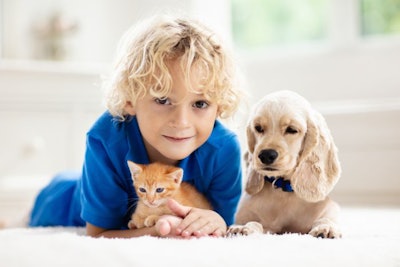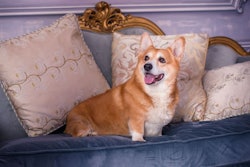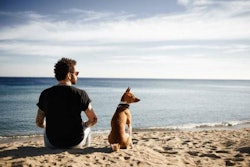
During the pandemic, pet owners have spent more time with both their pets and devices. Since actual sociability can be deadly, social media filled in for physical visits, while pets became one of the few touchable family members. The role of both social media and pets intertwines as animals’ own online presences increasingly influence consumers’ views of dog, cat and other pet food brands. In some cases, animals make better brand ambassadors because they are less likely to behave like beasts than people. Plus, cuteness is power in the persuasion game.
Social media influencers during COVID-19 pandemic
As the pandemic necessitated heavier use of computers and smartphones, social media influencers tapped into people’s unanticipated increased screen time. Influencers have shifted from food-porn Instagram shoots at quaint bistros only they know about, to curated home workouts or adorbs-able interior decoration tips, reported Fox Business.
Social media influencers develop followings by expressing their expertise on specific topics through their posts on Instagram, Twitter, Facebook and other platforms. Those social media influencers can become brand ambassadors when they speak positively about a particular company or product, or otherwise bring attention to it. In other words, when a guy with 500,000 followers Tweets out 280 characters of golden praise for a dog food, he’s a social media influencer acting as a brand ambassador.
Pet food e-commerce during pandemic
Those same screens populated by social media influencers have become a prime point of sale for pet food during the pandemic too. E-commerce pet food sales more than tripled in year-over-year sales growth between January and March. Pet food sales online were 21% higher in January 2020, compared to 2019, according to figures from Nielsen Global Connect. As of August 29, overall pet food sales volume still lagged behind last year, but value had returned to last year’s figures.
With online sales of pet food growing in importance, so too may the importance of social media influencers for pet food companies. Some of those brand ambassadors may be the pets themselves, or at least their owners channeling their thoughts. Pets as social media influencers can bring stronger brand security that humans, the founder of Dog Agency, a talent agency focused on animals, told the New York Times. Unlike human celebrity sponsors, a pet will never get drunk and Tweet out something offensive, she said.
A celebrity might take some bizarre dog food eating challenge on YouTube, but that’s not the kind of attention pet food brands want on social media. Instead, four-legged influencers endear themselves yet more to their followers if they cover their faces in kibble. It just shows they like their food, and it's just the kind of user-generated content a pet food company wants on their social media streams.
Social media influence marketing agency Mavrck looked at Purina PetCare’s presence on Instagram while studying social media best practices for pet food companies. Influencers made up 14% of Purina’s social media voice. Much of the content posted by influencers featured photos or videos of pets enjoying an active lifestyle, implying that activity was fueled by the pet food. One Purina social media campaign focused on emotional connections between pets and people, boosting brand authenticity.
Currently, late fashion designer Karl Lagerfeld’s cat has appeared in social media posts promoting a high-end cat hammock that attaches directly to the wall, reported AFP. Another dog, Winston the White Corgi, has a deal with dog food brand Honest Kitchen. Winston influences 230,000 Instagram followers.
Why do people trust brand ambassador animals?
Consumers know that the dog is really just a projection of its owner’s opinion, but a certain suspension of disbelief may occur. Perhaps pets inherently seem more honest than the primates who keep them. We’ve all been lied to by hairless apes before, especially on social media. It may sound Cynical, but dogs have a reputation for honesty dating back to ancient Greece. Maybe people are more inclined to heed a hound’s Tweet, since we often consider dogs to be guileless. A dog would never lie to you about his food. Likewise, cats’ reputation as finicky and discerning may put them in the role of cynical Garfield to innocent Odie on social media. Cats seem trustworthy, since they would surely let you know if something doesn’t please them. A cat’s vicious online review seems roughly equivalent to peeing in sneakers.
Cuteness also plays into it. Psychologists observe that people tend to trust attractive people, even those they don’t know, but react angrily to deceptive beauty. For example, scientists conducted an experiment testing whether attractive people would be considered more trustworthy in a game involving reciprocity. Attractive people were indeed trusted more and given more money, at first. However, if they didn’t pay back their benefactors properly, they suffered a subsequent punishment larger than average looking participants.
Among pets, cuteness takes the place of attractiveness. Even Nazis thought baby animals were cute, but they weren’t happy about it. Austrian ethologist, fascist and white supremacist Konrad Lorenz originated the concept of kindchenschema, or that various species evolved similar characteristics to encourage caregiving for young members of their own species. People think young animals are cute because their physical attributes happen to resemble those of human babies. Big eyes set in oversized heads, for example, make both puppies and kids cute. Lorenz, being a Nazi, considered this affection for young creatures to be a defect of human mental processing.
Another century of research on cuteness, mostly by non-fascists, developed a wider view of the psychological effects of cuteness on the human brain, reported Discover. In 2009, scientists published research results that people’s brains physically react differently to cutie-pies. Researchers manipulated photos of babies and toddlers to accentuate or reduce kindchenschema. The uber-cute kids triggered greater activity in the parts of the brain linked to attention and anticipation of reward. Other scientists brought the kindchenschema back home to baby animals. Animals that depend on parental care, including puppies, kitten and ducklings, tend to elicit a stronger caregiving response than a lizard that catches its own grubs from day one. Researchers observed that young animals’ degree of dependency mediates people’s caregiving feeling towards that little creature.
For pet food companies, the power of kindchenschema may have always played some role in marketing efforts, even if it was subconscious. Now, as dogs, cats and hedgehogs themselves become brand ambassadors, the influence of cuteness may grow. However, pet food brand ambassadors need to be trustworthy as well as cute. An obvious shill may just seem like a spokes-pet, with all due respect to Morris the Cat. Similarly, social media influencers work hard to build their follower’s trust and won’t throw that away easily. Ideally, a brand ambassador rises naturally, because they genuinely enjoy and recommend a pet product…or do so in the guise of a feline.















